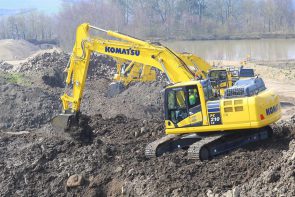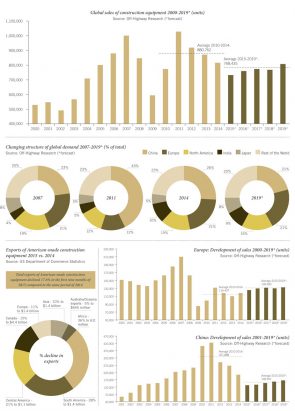Outlook for global construction equipment markets: Japan
First published in Global Report: Construction Equipment 2016 as Will earthmovers become the global growth champions?
 A PC210-LC-11 crawler excavator is among the latest key earthmoving models of Japanese construction equipment manufacturer Komatsu
A PC210-LC-11 crawler excavator is among the latest key earthmoving models of Japanese construction equipment manufacturer KomatsuDespite Japan’s construction industry contracting by 1.6% in real terms in 2014, the industry’s value is expected to pick up over the 2015–2019 period. Growing investments in residential and infrastructure markets will support this trend, according to Timetric CIC
Japan’s construction growth, creating opportunities for higher construction equipment sales, is likely to be supported by factors such as low unemployment rates, new public transport infrastructure, improvements in consumer and investor confidence and positive developments in regional economic conditions.
Sina Zavertha, a Timetric economist, said: “The country’s growing urbanisation will create fresh demand for the residential construction market over the forecast [2015-19] period. Consequently, we can expect market output to record a CAGR of 2.25% in nominal terms, to value JPY20.7 trillion (US$223.3 billion) in 2019.”
Overall, Japan’s construction industry is expected to reach a nominal value of JPY64.2 trillion (US$691 billion) in 2019, up from JPY56.3 trillion (US$587 billion) in 2014. However, there are risks to the positive outlook for construction industry growth in Japan in rising labour and construction materials costs.
Not all are as optimistic as Zavertha. Japan’s population is ageing and shrinking, suggesting less need for new infrastructure and a smaller working population paying taxes into government coffers. Consequently, some critics have been left bemused by Prime Minister Shinzo Abe’s hugely ambitious domestic and Asia-wide infrastructure spending programmes.
Meanwhile, others back the Japanese government’s spending, stressing the need to deliver, among other things, a successful 2020 Tokyo Olympics.
Japan boasts around 1.2 million kilometres of roads, giving it the world’s fifth-largest network. One of the current major Japanese highway network expansion projects is the $32billion construction of a second Tomei- Meishin Expressway, connecting Tokyo and Kobe via Nagoya. Japan is also reported to have 680,000 bridges, almost 10,000 tunnels, 250 bullet trains and 98 airports.
Some critics have talked of the country’s new infrastructure ‘white elephants’, citing, for example, the airport in Ibaraki, 85km north of Tokyo, which opened in 2010 at a cost of about $225 million as a hub for low-cost carriers. Now it is said to handle just six flights a day.
With further research indicating a declining number of motorists on Japanese roads, the huge but not indefinite spending on infrastructure by Abe may have provided only a short-term boost to construction equipment demand.
Adding further fuel to critical voices is the latest trading results of Japan-headquartered Komatsu, the world’s second-biggest manufacturer of construction and mining machinery after Caterpillar, who reported a 19% fall in Q2 2015 profit.
The construction equipment manufacturing giant’s net income in Q2 (July-September) 2015 fell to 32.6 billion yen (US$271 million) for the three months to September 30 from a revised 40.3 billion yen ($334.27 million) a year earlier.
Komatsu reiterated that full-year net income will probably fall 10% to 138 billion yen ($1.44 billion), while operating profit is likely to slip 8.7% to 221 billion yen ($1.83 billion).
Like all leading OEMs, Komatsu is battling the fallout from the slowdown in growth in China as well as the global slump in commodity markets.
Companies in this article
Caterpillar
Komatsu






